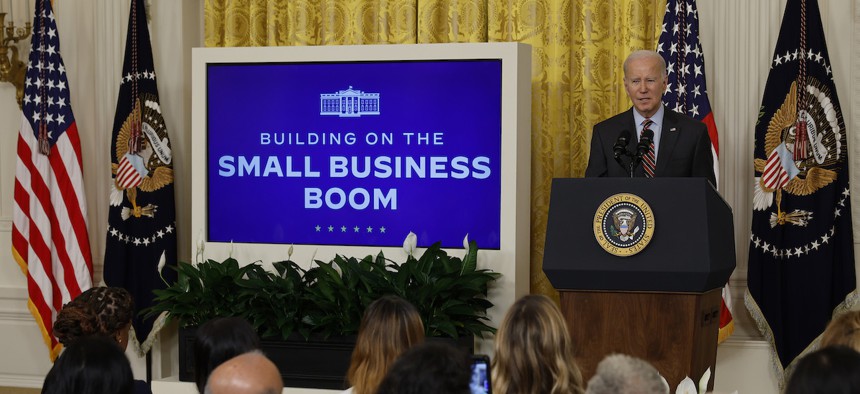
President Joe Biden delivers remarks while hosting the Small Business Administration's Women's Business Summit in the East Room of the White House on March 27, 2023. The agency’s inspector general said an examination of some federal contracts awarded to small businesses revealed provisions that direct larger companies to take a lion’s share of the work. Chip Somodevilla/Getty Images
OIG: Eligibility gaps are a major challenge for SBA next year
A report outlining ongoing management and performance challenges for the Small Business Administration includes critiques of set-aside contracts versus the amount of contracting dollars actually headed to small businesses.
Though the federal government has repeatedly met or exceeded its goal of setting aside 23% of its prime contracts for small businesses since fiscal 2013, a new inspector general’s report said the targets may not accurately reflect how much work is reaching those businesses.
The Small Business Administration’s OIG outlined management and performance challenges for the agency in fiscal 2024 in a report released on Monday, among them the accuracy of its annual Small Business Procurement Scorecard for federal agencies and the actual funding reaching procurement awardees.
“SBA’s achievement reports do not portray federal contracting dollars ultimately earned by small businesses, and this reduces the ability of Congress and other federal policymakers to determine whether the government is maximizing contracting opportunities for small businesses,” the report said.
The Small Business Procurement Scorecard, administered by SBA, tracks federal agencies’ ability to reach designated contracting goals, such as the 23% of all prime contracts to small businesses, socioeconomic prime and subcontracting goals and other specific targets.
Collectively, the federal government exceeded its goal in fiscal 2022 with 26% of contracts going to small businesses, but the OIG said an examination of some of those contracts revealed provisions that direct larger companies to take a lion’s share of the work.
“Although the agencies report these awards as part of their small business contracting goaling achievements, the true percentage of work performed is misreported in these instances,” the report said.
The OIG pointed to two reports examining SBA’s Disaster Assistance loan recommendation services and its COVID-19 Economic Relief Loan Programs, finding in each case that the agency didn’t monitor subcontracting limitations.
Regarding the COVID Economic Relief Loan programs, the OIG found that some prime awardees outsourced an average of 93% of their work to other companies on five contracts, well above the 50% subcontracting threshold. The 2022 report on the Economic Injury Disaster Loan program likewise found an instance where subcontracting limitations were exceeded by $13 million.
The OIG also pointed to instances where SBA failed to consistently identify ineligible contractors in its small business certification programs, allowing them to compete for set-aside contracts.
The report called for stronger eligibility controls, citing past examinations of gaps in SBA’s HUBZone; small, disadvantaged business; and Women-Owned Small Business programs that allowed ineligible firms to potentially compete for contracts.
The OIG noted that SBA has taken steps to close the gaps identified in the reports and is continuing to make progress on addressing controls for the HUBZone program, allowing for status reviews of small, disadvantaged businesses to ensure their eligibility and addressing risks in the WOSB program.







